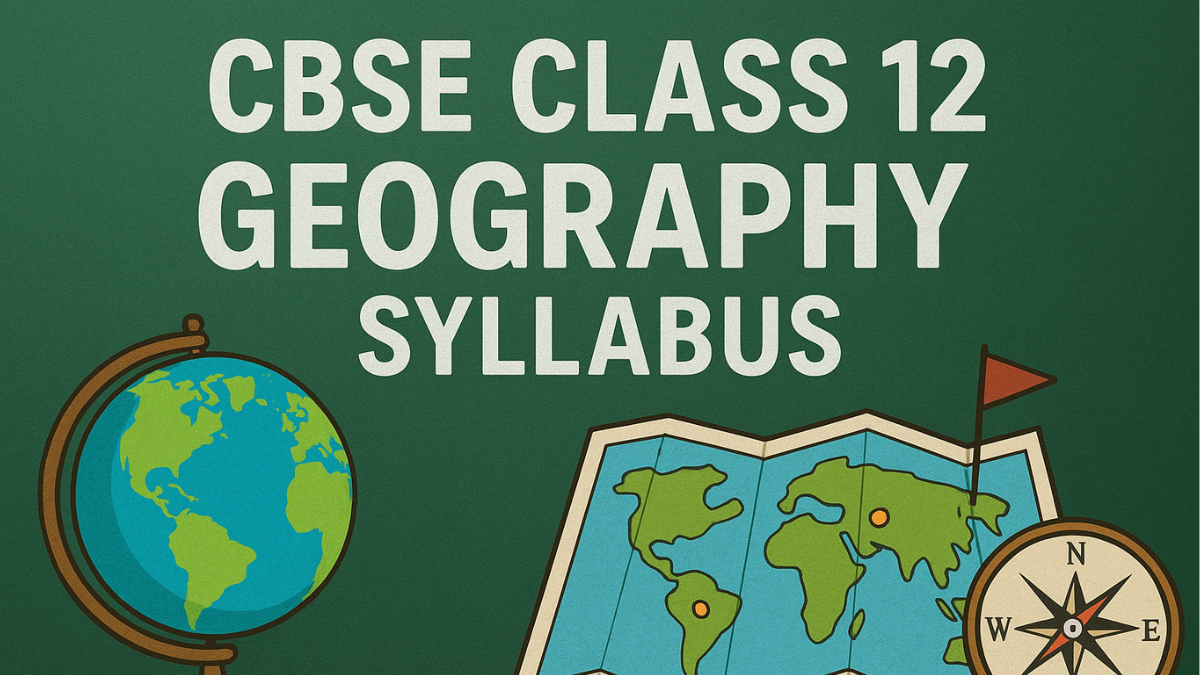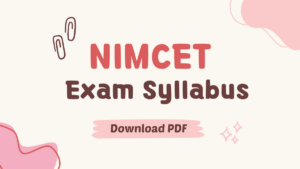The CBSE Class 12th Geography Syllabus 2025-26 is divided into two sections: A and B. Part A is for Fundamentals of Human Geography, which discusses the human population, its distribution, growth, and development. Part B discusses the Indian people and economy. CBSE has revealed the new syllabus for the upcoming academic year 2025-26.
This CBSE Class 12th geography syllabus 2025-26 includes thorough information about the course structure, content, and a list of practicals, among other things. Overview and download the CBSE Class 12 Geography Syllabus CBSE 2025-26 PDF from this page.
CBSE Class 12th Geography Syllabus 2025-26
Here is an overview of the CBSE Class 12 Geography section-wise syllabus.
|
Fundamentals of Human Geography
|
|||
| Chapter No. | Chapter Name | No. of periods | Weightage |
| Unit I | |||
| 1 | Human Geography | 7 | 3 |
| Unit II | |||
| 2 | The World Population Density Distribution and Growth | 9 |
8
|
| 3 | Human Development | 7 | |
| Unit III | |||
| 4 | Primary Activities | 12 |
19
|
| 5 | Secondary Activities | 10 | |
| 6 | Tertiary and Quaternary Activities | 10 | |
| 7 | Transport, Communication and Trade | 15 | |
| 8 | International Trade | 10 | |
| Map Work (Based on the identification of features on the World Political Map) | 10 | 5 | |
| Total | 90 | 35 | |
|
India People and Economy
|
|||
| Chapter No. | Chapter Name | No. of Periods | Weightage |
| Unit I | |||
| 1 | Population Distribution Density Growth and Composition | 10 | 5 |
| Unit II | |||
| 2 | Human Settlements | 8 | 3 |
| Unit III | |||
| 3 | Land Resources and Agriculture | 9 |
10
|
| 4 | Water Resources | 9 | |
| 5 | Mineral And Energy Resources | 9 | |
| 6 | Planning and Sustainable Development in the Indian Context | 7 | |
| Unit IV | |||
| 7 | Transport and Communication | 11 |
7
|
| 8 | International Trade | 9 | |
| Unit V | |||
| 9 | Geographical Perspective on selected issues and problems | 8 | 5 |
| Map Work (Based on Marking and labelling on a political Map of India) | 10 | 5 | |
| Total | 90 | 35 | |
| Geography Practical-II | |||
| Chapter No. | Chapter Name | Period | Weightage |
| 1 | Data source and Compilation | 5 |
18
|
| 2 | Data Processing | 8 | |
| 3 | Graphical Representation of Data | 15 | |
| 4 | Spatial Information Technology | 12 | 7 |
| Practical Record Book and Viva Voce | 5 | ||
| Total | 40 | 30 | |
Class 12th Geography Syllabus 2025-26: Unit 1
Chapter 1: Human Geography: Nature and Scope
- Introduction to Human Geography
- Approaches to study Human Geography Regional and Systematic
Geography, Dualism - Nature of Human Geography
- Naturalisation of Humans and Humanisation of Nature
- Schools of thought in Human Geography
- Fields and subfields of Human Geography
Unit 2:
Chapter- 2 The World Population Distribution, Density and Growth
Population-distribution and density
Factors influencing the distribution of population
Population Growth
Components of Population change
Demographic Transition
Population Control Measures
Chapter- 3 Human Development
- Human development – concept; selected indicators
- Growth and Development
- The four pillars of Human Development
- Approaches to Human Development
- Measuring Human Development- HDI, HPI and GNH
- International comparisons
Unit 3:
Chapter- 4 Primary Activities Concept and types:
- Hunting and Gathering, Pastoralism; Nomadic Herding, Commercial Livestock Rearing
- Types of agriculture:
❖ Primitive Subsistence
❖ Intensive Subsistence
- Commercial Agriculture
❖ Plantation Agriculture
❖ Extensive Commercial Grain Cultivation
❖ Mixed Farming
❖ Dairy farming
❖ Mediterranean Agriculture
❖ Market Gardening and Horticulture
❖ Cooperative Farming
❖ Collective Farming - Mining, factors affecting mining
- Methods of MiningChapter- 5 Secondary Activities
● Manufacturing: Characteristics of Modern large-Scale Manufacturing
● Factors influencing industrial Location
● Classification of manufacturing Industries: On the basis of Size, Inputs
/raw material, Output /Products and Ownership
● Concept of High tech Industry
Chapter- 6 Tertiary Activities
● Tertiary activities-concept and types
● Trade and commerce: Retail and Wholesale trading Transport, Factors
Affecting Transport;
● Communication
● Services
● People engaged in tertiary activities
● Tourism, Major tourist regions
● Tourist attractions – some examples from selected countries
● Medical Services for Overseas Patients in India
● Quaternary and Quinary activities-concept
● The Digital Divide
Chapter- 7 Transport and Communication
● Transport
● Modes of Transportation:
● Land transport: Roadways, Highways, Road Density, Border Roads.
● Railways: Trans-continental Railways: Trans-Siberian, Trans Canadian,
Australian Trans Continental,
● Water Transport: Important Sea Routes, Shipping Canals, Inland
waterways
● Air transport: Inter-Continental air routes
● Pipelines
● Communications: Satellite Communications and Cyber Space- Internet
Chapter- 8 International Trade
● History of International trade
● Why Does International Trade Exist?
● Basis of International Trade
● Balance of Trade
● Types of International Trade: Bilateral and Multi-lateral trade
● Case for Free Trade
● Concept of Dumping
● World Trade Organisation
● Regional Trade Blocs
● Concerns Related to International Trade
● Gateways of International trade: Ports
● Types of Port
16
Book: India: People and Economy
Unit 1:
Chapter- 1 Population Distribution, Density, Growth and Composition
Distribution of Population
Density of Population
Growth of population
Four distinct phases of population growth
Regional Variation in Population Growth
Population Composition: Rural – Urban Composition, Linguistic
Composition, Religious Composition
Composition of Working Population
Promoting Gender Sensitivity through ‘Beti Bachao–Beti Padhao’ Social Campaign.
Unit 2:
Chapter- 2 Human Settlements
Rural settlements – types and distribution
Urban settlements – types, distribution
Evolution of Towns in India
Urbanisation in India
Functional Classification of Towns
Smart Cities Mission
Unit 3:
Chapter- 3 Land Resources and Agriculture
Land resources- general land use
Land use categories
Land-use Changes in India
Common Property Resources
Agricultural Land Use in India
Cropping Seasons in India
Types of Farming
Geographical conditions and distribution of major crops (Wheat, Rice,
Tea, Coffee, Cotton, Jute, Sugarcane and Rubber);
Agricultural development in India
Growth of Agricultural Output and Technology
Problems of Indian Agriculture
Chapter- 4 Water Resources
Water resources- Surface water and Groundwater Resources
Lagoons and Backwaters
Water Demand and Utilisation – irrigation, domestic, industrial and other
uses;
Emerging Water Problems: Deterioration of Water Quality
Water Conservation and Management; Prevention of Water Pollution;
Rain water harvesting and Watershed management
Chapter- 5 Mineral and Energy Resources
Mineral Resources: Introduction and Types
17
Major mineral belts of India
Distribution of Ferrous Minerals (Iron ore and Manganese), Non-Ferrous
Minerals (Bauxite and Copper); Non-metallic minerals (Mica)
Energy Resources: Conventional sources (Coal, Petroleum and Natural
gas) and non-conventional sources (Nuclear, Solar, Wind, Tidal and
Wave and Geothermal and Bio energy)
Conservation of Mineral Resources
Chapter – 6 Planning and Sustainable Development in Indian Context
- Planning- Introduction
- Target Area Planning: Hill Area Development Programme, Drought-Prone Area Programme.
- Concept of Sustainable Development Case Studies –
1. Integrated Tribal Development Project in Bharmaur* Region,
2. Indira Gandhi Canal (Nahar) Command Area
Unit 4:
Chapter- 7 Transport and Communication
● Means of transport: Land (Road transport, Rail transport and Oil and
Gas pipelines), Water transport (Inland waterways and Oceanic routes)
and Air transport
● Communication Networks- Personal and Mass Communication Systems
Chapter 8: International Trade
Changing Pattern of the Composition of India’s Exports and Import
Direction of Trade
Sea Ports as Gateways of International Trade
Major Seaports of India along with their hinterlands.
Airports
Class 12th Geography Syllabus Unit 5
Chapter 9: Geographical Perspective on Selected Issues and Problems
● Environmental pollution- Introduction and types
● Urban-waste disposal
● Rural-Urban Migration: Case Study
● Problems of Slums
● Land degradation: Case study









 CUET Commerce Syllabus 2026, Download Su...
CUET Commerce Syllabus 2026, Download Su...
 CUET PG Hindi Syllabus 2026, Download CU...
CUET PG Hindi Syllabus 2026, Download CU...
 NIMCET Syllabus 2026, Download Subject-w...
NIMCET Syllabus 2026, Download Subject-w...














